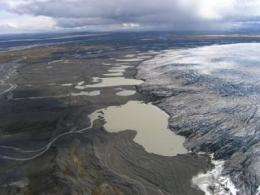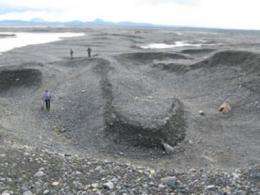Newly discovered drumlin field provides answers about glaciation and climate

The landform known as a drumlin, created when the ice advanced during the Ice Age, can also be produced by today's glaciers. This discovery, made by researchers from the University of Gothenburg, Sweden, has just been published in the scientific journal Geology.
Drumlins generally consist of an accumulation of glacial debris – till – and are found in areas that were covered by ice sheet. As the ice advanced, it moved rocks, gravel and sand and created tear-shaped raised ridges running parallel with the movement of the ice.
"Until now, scientists have been divided on how drumlins were created," says Mark Johnson from the Department of Earth Sciences at the University of Gothenburg. "Because they are formed under the ice, it's not an observable process. Drumlins are common almost everywhere the Ice Age ice sheets existed, but they're almost unknown with modern-day glaciers. Now, though, we've found a new drumlin field by the Múlajökull glacier on Iceland. It's quite unique."

The melting of glaciers reveals drumlins
The melting of glaciers as a result of climate change has helped the researchers to study this geological phenomenon. The drumlin discovery on Iceland has presented unique opportunities to study their structure.
"One of the drumlins we found was sliced through by erosion. This gave us an opportunity to study it layer by layer, and it was clear that it had been built up only recently. In other words, the glacier has not just retreated to reveal old drumlins, but is continuing to create new ones."
There are currently multiple theories about the origins of drumlins. The Gothenburg researchers' discovery shows that they can form within two kilometres of the edge of the ice.
"A surging glacier can move 100 metres a day, as opposed to the more normal 100 metres a year. If we can link drumlins to fast-moving glaciers, this would mean that the ice sheet advanced much more quickly than scientists currently believe."
Can effect climate research
The link between drumlins and rapid ice movements is important for climate research. When modelling climate change, we need to know how high and how cold a glacier was in order to understand the last Ice Age. A glacier that moves quickly will not be as thick. This discovery could therefore affect how scientists approach climate modelling.

Solving the riddle of the drumlin is a longstanding dream for Mark Johnson:
"We discovered the drumlin field while flying in towards the edge of the glacier to do a completely different study. It was the most exciting thing I've been involved in during my research. All geologists know about drumlins, and when I began to study geology in Wisconsin in the 1980s, many people would come there to study the drumlins in the area. Coming up with a theory for how they formed was a big question even then."
The discovery of the new drumlin field was made by Mark Johnson from the Department of Earth Sciences at the University of Gothenburg in collaboration with researchers from Iceland, Norway and the UK.
Provided by University of Gothenburg


















